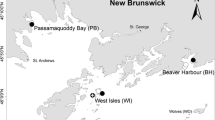Abstract
Juveniles of the tube-dwelling polychaete L. conchilega were found attached to adult tubes at an exposed beach in South Wales (U.K.). They attached to the upper part of tubes protruding above the sediment. The aim of this study was to determine the timing of juvenile settlement on to adult tubes, their abundance and size distribution, and the time of detachment and densities in the sediment after re-settlement. Furthermore, to establish whether the sediment composition of juvenile tubes differed from those of adults and the surrounding sediment. In 1998, 1999 and 2000, tubes of adult L. conchilegawere sampled and numbers of attached juveniles were quantified and their sizes measured. Densities of solitary L. conchilega in the sediment were estimated, as well as the size distribution of solitary tubes. On average, 5–13 juveniles were attached to single adult tubes in spring, but numbers varied greatly with up to 72 juveniles on a single tube in April 1998. Availability of a hard substratum and chemical cues are discussed as potential factors triggering the attachment of juveniles to adult tubes. Juveniles started to detach and re-settle in the sediment 1 month after attachment. Once settled in the sediment, juvenile numbers decreased steeply, but the size distribution of solitary L. conchilega suggested that some juveniles survived in the population. However, the extent to which numbers of juvenile recruits contribute to the density of adults remained unclear. Juveniles used a smaller mean particle size for tube building than adults, but both actively selected particles.
Similar content being viewed by others
References
Bhaud, M. R., 2000. Two contradictory elements determine invertebrate recruitment: dispersion of larvae and spatial restrictions on adults. Oceanol. Acta 23: 409–422.
Bryan, P. J., P. Y. Qian, J. L. Kreider & F. S. Chia, 1997. Induction of larval settlement and metamorphosis by pharmacological and conspecific associated compounds in the serpulid polychaete Hydroides elegans. Mar. Ecol. Prog. Ser. 146: 81–90.
Buhr, K. J. & J. E. Winter, 1977. Distribution and maintenance of a Lanice conchilega association in the Weser estuary (FRG), with special reference to the suspension-feeding behaviour of Lanice conchilega. In Keegan, B. F., P. O. Ceidigh & P. J. S. Boaden (eds), Biology of Benthic Organisms. 11th European Symposium on Marine Biology, Gallaway, Oct. 1976. Pergamon Press, Oxford and New York: 101–113.
Burke, R. D., 1986. Pheromones and the gregarious settlement of marine invertebrate larvae. Bull. mar. Sci. 39: 323–331.
Carey, D. A., 1987. Sedimentological effects and paleoecological implications of the tube-building polychaete Lanice conchilega Pallas. Sedimentology 34: 49–66.
Daniel, W. W, 1978. Applied Nonparametric Statistics. Houghton Mifflin Company.
Fager, E. W., 1964. Marine sediments: Effects of a tube-building polychaete. Science 143: 356–358.
Féral, P., 1989. Influence des populations de Lanice conchilega (Pallas) (Annelida, Polycheta) sur la sedimetation sableuse intertidale de deux plages bas-normandes (France). Bull. soc. geol. France 8: 1193–1200.
Gruet, Y., 1984. Granulometric evolution of the sand tube in relation to growth of the polychaete annelid Sabellaria alveolata (Linne) (Sabellariidae). Ophelia 23: 181–193.
Heimler, W., 1981. Untersuchunger zur Lavalentwicklung von Lanice conchilega (Pallas) 1766 (Polychaeta, Terebellomorpha) Tiel 1: Entwicklungsablauf. Zool. Jb. Anat. 106: 12–45.
Hertweck, G., 1995. Verteilung charakteristischer Sedimentkörper und der Benthossiedlungen im Rückseitenwatt der Insel Spiekeroog, südliche Nordsee. 1. Wattkartierung 1988-1992. Senckenbergiana marit. 26: 81–94.
Heuers, J. & S. Jaklin, 1999. Initial settlement of Lanice conchilega. Senckenbergiana marit. 29 (Suppl.): 67–69.
Heuers, J., S. Jaklin, R. Zühlke, S. Dittmann, C. P. Günther, H. Hildebrandt & V. Grimm, 1998. A model on the distribution and abundance of the tube-building polychaete Lanice conchilega (Pallas, 1766) in the intertidal of theWadden Sea. Verhandl. Ges. Ökol. 28: 207–215.
Holthe, T., 1978. The Zoogeography of the Terebellomorpha (Polychaeta) of the Northern European Waters. Sarsia 63: 191–198.
Jensen, R. A. & D. E. Morse, 1984. Intraspecific facilitation of larval recruitment: gregarious settlement of the polychaete Phrag- 130 matopoma californica (Fewkes). J. exp. mar. Biol. Ecol. 83: 107–126.
Jones, S. E. & C. F. Jago, 1993. Insitu assessment of modification of sediment properties by burrowing invertebrates. Mar. Biol. 115: 133–142.
Kessler, M., 1963. Die Entwicklung von Lanice conchilega (Pallas) mit besonderer Berücksichtigung der Lebensweise. Helgol. wiss. Meeresunters. 8: 425–476.
Marcano, G. & M. R. Bhaud, 1995. New observations on the terebellid (Polychaeta) aulophore larvae on the French coasts. Ophelia 43: 229–244.
Pawlik, J. R., 1992. Chemical ecology of the settlement of benthic marine invertebrates. Oceanogr. mar. biol. Ann. Rev. 30: 273- 335.
Petersen, B. & K. M. Exo, 1999. Predation of waders and gulls on Lanice conchilega tidal flats in theWadden Sea. Mar. Ecol. Prog. Ser. 178: 229–240.
Ropert, M. & J. C. Dauvin, 2000. Renewal and accumulation of a Lanice conchilega (Pallas) population in the bale des Veys, western Bay of Seine. Oceanol. Acta 23: 529–546.
Strasser, M. & U. Pieloth, 2001. Recolonization pattern of the polychaete Lanice conchilega on an intertidal sand flat following the severe winter of 1995/1996. Helgol. mar. Res. 55: 176–181.
Tamaki, A., 1987. Comparison of resistivity to transport by wave action in several polychaete species on an intertidal sand flat. Mar. Ecol. Prog. Ser. 37: 181–189.
Toonen, R. J. & J. R. Pawlik, 2001. Settlement of the gregarious tube worm Hydroides dianthus (Polychaeta: Serpulidae). I. Gregarious and nongregarious settlement. Mar. Ecol. Prog. Ser. 224: 103–114.
Tucker, M., 1988. Techniques in Sedimentology. Blackwell Scientific Publications. 394 pp.
Unabia, C. R. C. & M. G. Hadfield, 1999. Role of bacteria in larval settlement and metamorphosis of the polychaete Hydroides elegans. Mar. Biol. 133: 55–64.
Wilson, D. P., 1968. The settlement behaviour of the larvae of Sabellaria alveolata (L.). J. mar. biol. Ass. U.K. 48: 387–435.
Ziegelmeier, E., 1952. Beobachtungen ueber den Röhrenbau von Lanice conchilega (Pallas) im Experiment und am natürlichen Standort. Helgol. wiss. Meeresunters. 4: 107–129.
Author information
Authors and Affiliations
Rights and permissions
About this article
Cite this article
Callaway, R. Juveniles stick to adults: recruitment of the tube-dwelling polychaete Lanice conchilega (Pallas, 1766). Hydrobiologia 503, 121–130 (2003). https://doi.org/10.1023/B:HYDR.0000008494.20908.87
Issue Date:
DOI: https://doi.org/10.1023/B:HYDR.0000008494.20908.87




